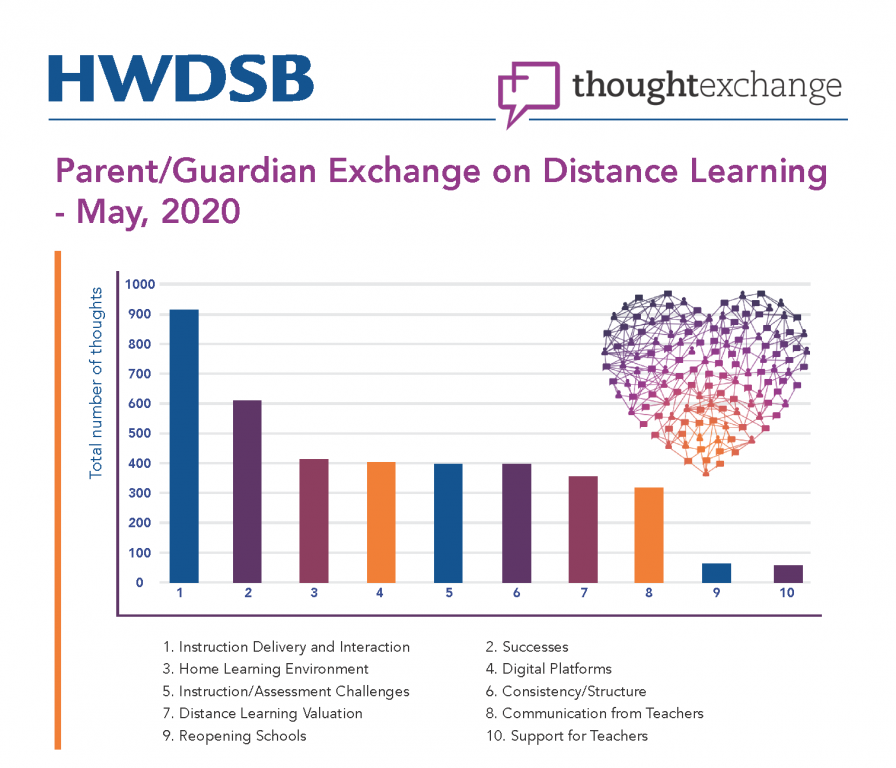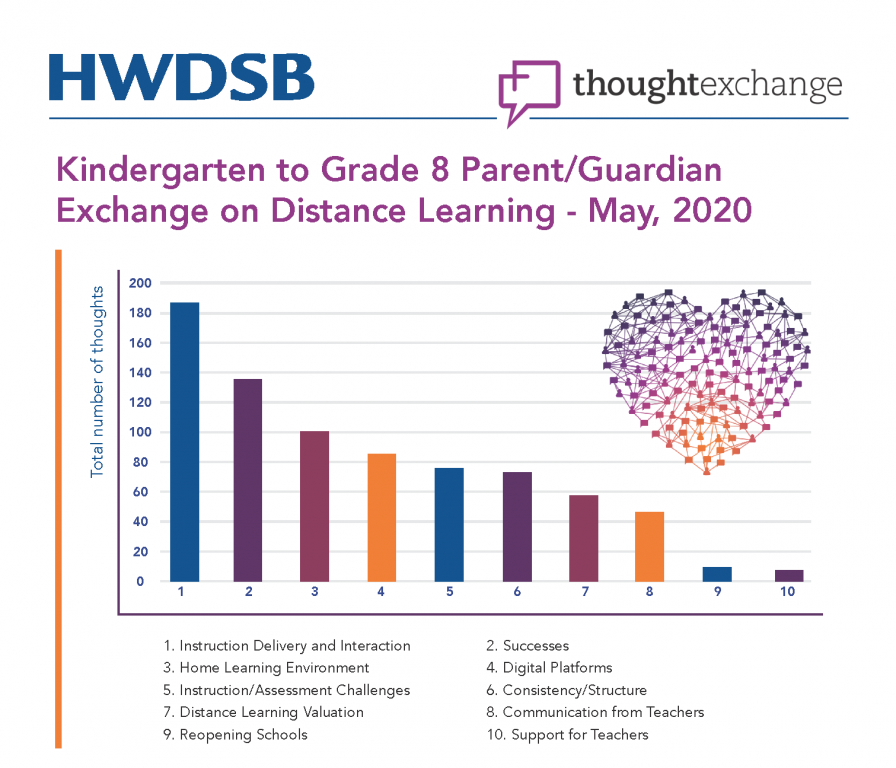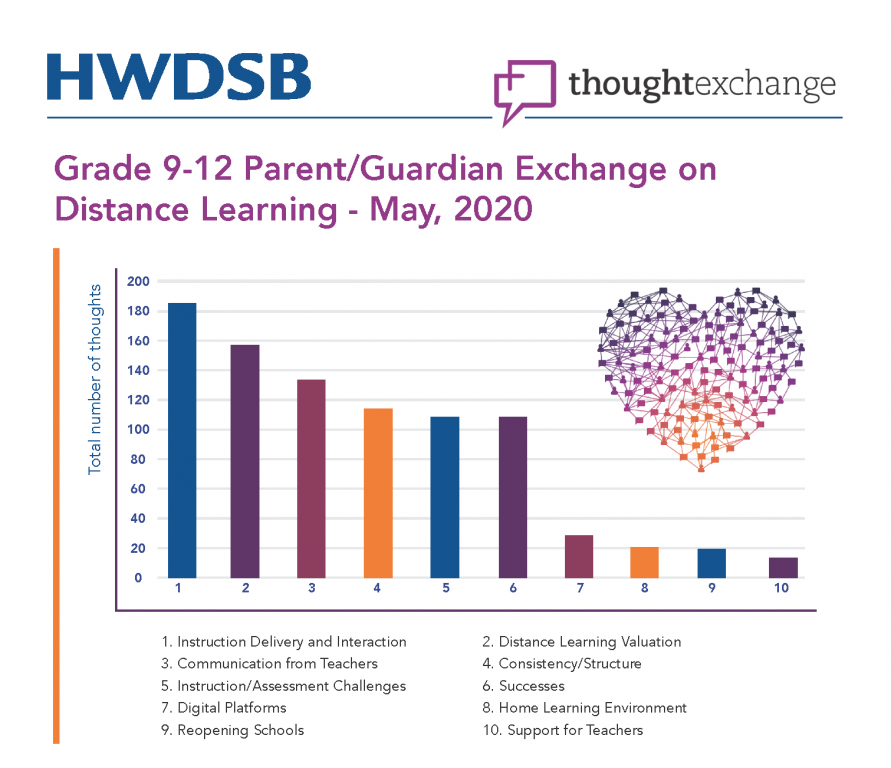
 Thank you to everyone who participated in the recent Thoughtexchange conversation. This “check in” will help us learn more about your views and experiences related to distance learning at HWDSB.
Thank you to everyone who participated in the recent Thoughtexchange conversation. This “check in” will help us learn more about your views and experiences related to distance learning at HWDSB.
This is a challenging period and we appreciate the efforts families are making to support student learning and well-being. We will continue to support you along the way. We are listening to your input, know we have work to do and will adjust how we move forward.
Question: Now that you have experienced distance learning, what is working well and what can we improve?
Participation Rate
| Parents/Guardians of Elementary Students | Parents/Guardians of Secondary Students | Community Members | Total | |
| Participants | 2,714 | 822 | 473 | 4,009 |
| Thoughts Shared | 4,742 | 1,315 | 368 | 6,425 |
| Ratings Assigned | 98,585 | 29,022 | 6,832 | 134,439 |
What we heard
Common themes among the thoughts that were rated 3.3 stars to 5 stars.
- Instruction Delivery and Interaction – Parents/guardians recognize the importance of teacher presence in distance learning and some advocate for face-to-face instruction from teachers periodically or every day, while others want pre-recorded videos of teachers teaching lessons (so that there is no commitment to real-time scheduling). Some want regular “office hours” or one-to-one conversations so students can ask questions. Many parents/guardians advocate for opportunities for their students to connect with their classmates online as well.
- Successes – prompt feedback, flexibility with timelines, frequent personal communication, the week’s work laid out in advance, variety in learning tasks, positive messaging – these are the success stories of distance learning that parents/guardians have shared.
- Instruction/Assessment Challenges — Parents/guardians have observed that learning tasks are often too difficult for students to complete on their own. The workload for some is high and deadlines tight which results in too much screen time, and anxiety. Many parents/guardians observe that assignments do not come with accompanying instruction and families struggle to learn new concepts together. Special Education needs are difficult to meet in this learning environment and engagement is challenging for some.
- Home Learning Environment – Families have different circumstances that present challenges when students must learn at home. Many parents are working full time, some at home, some as essential workers and front-line health care workers; some have lost jobs; some have multiple children at home, including babies and toddlers; some are caring for aging parents, some speak languages other than English. Some homes have unreliable or slow internet, no printer, and too few or aging devices. Many parents/guardians express feeling stressed, frustrated, guilty and sometimes overwhelmed by the situation that distance learning has brought home.
- Consistency/Structure – Juggling work, parenting and school responsibilities is one of the challenges parents/guardians say is magnified by differences in how teachers approach online learning. Differences in how often teachers engage students and how much work they assign becomes a problem in households with multiple students or when students compare experiences with their friends. Some parents/guardians ask for coordination between teachers when planning assignments to ensure equity and reasonable workload, especially for students with multiple teachers. Structure in terms of weekly expectations laid out in advance, posted on the same day, would help families to plan ahead.
- Distance Learning Valuation – Parents/guardians commented on the role of distance learning as a schooling option and observed that it may work in the interim as an emergency measure but doesn’t meet the needs of all learners, especially those who need one-to-one support and variety in learning experiences; it doesn’t adequately cover areas of the curriculum that require hands-on learning skills; it can be demotivating to some (especially when they know their marks can’t go down); it can result in too much screen time; It doesn’t meet students’ social needs and it can be very stressful. Most parents/guardians expressed that nothing replaces being in the classroom with the teacher.
- Digital Platforms – The many different ways in which educators engage students through online platforms and web apps is a challenge to families needing to assist students to find and submit work, log in and remember passwords. This is part of the distance learning that adds to the frustration and time demands on busy parents/guardians who ask for a standardized approach across the board with one learning platform and fewer apps.
- Communication from Teachers – Parents/guardians value frequent, personalized contact and feedback by teachers for students. Knowing how students are doing relieves anxiety. Receiving personalized messages/calls and feedback motivates students and helps them cope with the uncertainty of this situation.
- Reopening Schools – Most parents/guardians who submitted thoughts about schools reopening expressed concern over the Ministry opening schools too early, about the ability to maintain cleanliness and social distancing at school, and about everyone’s safety.
- Support for Teachers – Parents/guardians recognize that teachers were thrown into distance learning with no warning and that some teachers have little to no experience with online learning platforms and could benefit from training opportunities.
What’s Next?
You have given us a lot to think about:
- We will dig deeper into the data to better understand the issues you raised;
- We will use this information to inform our decision-making about next steps for supporting staff, students and families;
- We will bring this information to our Principals, our Program, Equity & Well-Being, Special Education and IIT teams;
- We will use it to refine the messaging, supports and resources available to staff, students and parents/guardians.
What we heard
Common themes among the thoughts that were rated 3.3 stars to 5 stars.
- Instruction Delivery and Interaction – Parents/guardians recognize the importance of teacher presence in distance learning and some advocate for face-to-face instruction from teachers periodically or every day, while others want pre-recorded videos of teachers teaching lessons (so that there is no commitment to real-time scheduling). Some want regular “office hours” or one-to-one conversations so students can ask questions. Many parents/guardians advocate for opportunities for their students to connect with their classmates online as well.
- Successes – prompt feedback, flexibility with timelines, frequent personal communication, the week’s work laid out in advance, variety in learning tasks, positive messaging – these are the success stories of distance learning that parents/guardians have shared.
- Home Learning Environment – Families have different circumstances that present challenges when students must learn at home. Many parents are working full time, some at home, some as essential workers and frontline health care workers; some have lost jobs; some have multiple children at home, including babies and toddlers; some are caring for aging parents, some don’t speak English. Some homes have spotty internet, no printer, and too few or aging devices. Many parents/guardians express feeling stressed, frustrated, guilty and sometimes overwhelmed by the situation that distance learning has brought home.
- Digital Platforms – The many different ways in which educators engage students through online platforms and web apps is a challenge to families needing to assist students to find and submit work, log in and remember passwords. This is part of the distance learning that adds to the frustration and time demands on busy parents/guardians who ask for a standardized approach across the board with one learning platform and fewer apps.
- Instruction/Assessment Challenges — Parents/guardians have observed that learning tasks are often too difficult for students to complete on their own. The workload for some is high and deadlines tight which results in too much screen time, and anxiety. Many parents/guardians observe that assignments do not come with accompanying instruction and families struggle to learn new concepts together. Special Education needs are difficult to meet in this learning environment and engagement is challenging for some.
- Consistency/Structure – Juggling work, parenting and school responsibilities is one of the challenges parents/guardians say is magnified by differences in how teachers approach online learning. Differences in how often teachers engage students and how much work they assign becomes a problem in households with multiple students or when students compare experiences with their friends. Some parents/guardians ask for coordination between teachers when planning assignments to ensure equity and reasonable workload, especially for students with multiple teachers. Structure in terms of weekly expectations laid out in advance, posted on the same day, would help families to plan ahead.
- Distance Learning Valuation – Parents/guardians commented on the role of distance learning as a schooling option and observed that it may work in the interim as an emergency measure but doesn’t meet the needs of all learners, especially those who need one-to-one support and variety in learning experiences; it doesn’t adequately cover areas of the curriculum that require hands-on learning skills; it can be demotivating to some (especially when they know their marks can’t go down); it can result in too much screen time; It doesn’t meet students’ social needs and it can be very stressful. Most parents/guardians expressed that nothing replaces being in the classroom with the teacher.
- Communication from Teachers – Parents/guardians value frequent, personalized contact and feedback by teachers for students. Knowing how students are doing relieves anxiety. Receiving personalized messages/calls and feedback motivates students and helps them cope with the uncertainty of this situation.
- Reopening Schools – Most parents/guardians who submitted thoughts about schools reopening expressed concern over the Ministry opening schools too early, about the ability to maintain cleanliness and social distancing at school, and about everyone’s safety.
- Support for Teachers – Parents/guardians recognize that teachers were thrown into distance learning with no warning and that some teachers have little to no experience with online learning platforms and could benefit from training opportunities.
What’s Next?
You have given us a lot to think about:
- We will dig deeper into the data to better understand the issues you raised;
- We will use this information to inform our decision-making about next steps for supporting staff, students and families;
- We will bring this information to our Principals, our Program, Equity & Well-Being, Special Education and IIT teams;
- We will use it to refine the messaging, supports and resources available to staff, students and parents/guardians.
What we heard
Common themes among the thoughts that were rated 3.3 stars to 5 stars.
- Instruction Delivery and Interaction – Parents/guardians recognize the importance of teacher presence in distance learning and some advocate for face-to-face instruction from teachers periodically or every day, while others want pre-recorded videos of teachers teaching lessons (so that there is no commitment to real-time scheduling). Some want regular “office hours” or one-to-one conversations so students can ask questions. Many parents/guardians advocate for opportunities for their students to connect with their classmates online as well.
- Distance Learning Valuation – Parents/guardians commented on the role of distance learning as a schooling option and observed that it may work in the interim as an emergency measure but doesn’t meet the needs of all learners, especially those who need one-to-one support and variety in learning experiences; it doesn’t adequately cover areas of the curriculum that require hands-on learning skills; it can be demotivating to some (especially when they know their marks can’t go down); it can result in too much screen time; It doesn’t meet students’ social needs and it can be very stressful. Most parents/guardians expressed that nothing replaces being in the classroom with the teacher.
- Communication from Teachers – Parents/guardians value frequent, personalized contact and feedback by teachers for students. Knowing how students are doing relieves anxiety. Receiving personalized messages/calls and feedback motivates students and helps them cope with the uncertainty of this situation.
- Consistency/Structure – Juggling work, parenting and school responsibilities is one of the challenges parents/guardians say is magnified by differences in how teachers approach online learning. Differences in how often teachers engage students and how much work they assign becomes a problem in households with multiple students or when students compare experiences with their friends. Some parents/guardians ask for coordination between teachers when planning assignments to ensure equity and reasonable workload, especially for students with multiple teachers. Structure in terms of weekly expectations laid out in advance, posted on the same day, would help families to plan ahead.
- Instruction/Assessment Challenges — Parents/guardians have observed that learning tasks are often too difficult for students to complete on their own. The workload for some is high and deadlines tight which results in too much screen time, and anxiety. Many parents/guardians observe that assignments do not come with accompanying instruction and families struggle to learn new concepts together. Special Education needs are difficult to meet in this learning environment and engagement is challenging for some.
- Successes – prompt feedback, flexibility with timelines, frequent personal communication, the week’s work laid out in advance, variety in learning tasks, positive messaging – these are the success stories of distance learning that parents/guardians have shared.
- Digital Platforms – The many different ways in which educators engage students through online platforms and web apps is a challenge to families needing to assist students to find and submit work, log in and remember passwords. This is part of the distance learning that adds to the frustration and time demands on busy parents/guardians who ask for a standardized approach across the board with one learning platform and fewer apps.
- Home Learning Environment – Families have different circumstances that present challenges when students must learn at home. Many parents are working full time, some at home, some as essential workers and frontline health care workers; some have lost jobs; some have multiple children at home, including babies and toddlers; some are caring for aging parents, some don’t speak English. Some homes have spotty internet, no printer, and too few or aging devices. Many parents/guardians express feeling stressed, frustrated, guilty and sometimes overwhelmed by the situation that distance learning has brought home.
- Reopening Schools – Most parents/guardians who submitted thoughts about schools reopening expressed concern over the Ministry opening schools too early, about the ability to maintain cleanliness and social distancing at school, and about everyone’s safety.
- Support for Teachers – Parents/guardians recognize that teachers were thrown into distance learning with no warning and that some teachers have little to no experience with online learning platforms and could benefit from training opportunities.
What’s Next?
You have given us a lot to think about:
- We will dig deeper into the data to better understand the issues you raised;
- We will use this information to inform our decision-making about next steps for supporting staff, students and families;
- We will bring this information to our Principals, our Program, Equity & Well-Being, Special Education and IIT teams;
- We will use it to refine the messaging, supports and resources available to staff, students and parents/guardians.
Updated on Thursday, May 21, 2020.

